SSD-driven performance, plus rating
To get an idea of how quick the Kingston and Tsunami combo is, we test the drive by connecting it to the USB 3.0 port found on our ASUS P6X58D Premium motherboard.
We expect the USB 3.0 speeds to be impressive, but to see how well it compares, we'll also provide benchmark numbers for a 128GB USB 3.0 all-in-one enclosure (Kingston HyperX MAX), 64GB USB 3.0 Flash drive (Kingston's Data Traveler Ultimate) and a 160GB USB 2.0 hard disk (Freecom's Mobile Drive XXS). Incidentally, the two Kingston SSDs inside the HyperMax and Tsunami are the same.
Update: due to popular demand, we're including a 160GB, 7,200RPM mechanical hard-drive's results in the Tsunami enclosure. The Samsung HM161JJ is freshly formatted and run via both USB 3.0 and USB 2.0 connections - the latter achieved by simply plugging the USB 3.0 cable into a USB 2.0 port on the ASUS motherboard. It doesn't need external power, which is good news for folk looking to have a one-cable, portable solution.
All drives are formatted to the NTFS file system before benchmarking, and we run a series of six tests, all of which are detailed below.
Synthetic benchmarks - AS SSD
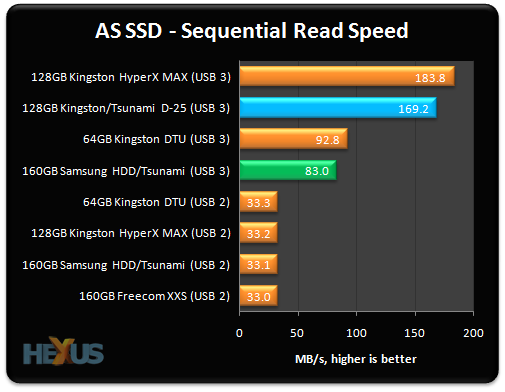
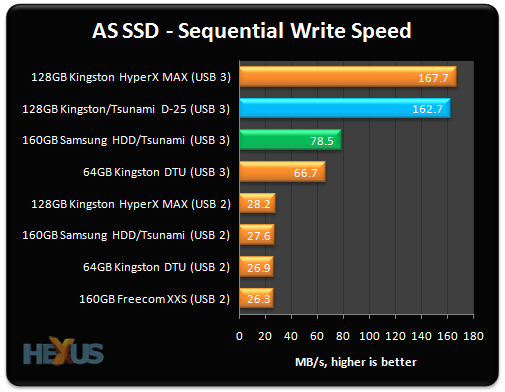
USB 3.0 trounces USB 2.0 in the sequential-speed test. The Tsunami caddy, equipped with an SSD, is almost 6x faster than a USB 2.0-based enclosure, and the numbers suggest that, given a suitably fast SSD inside, 10GB/m transfers are possible.
Even a mechanical drive produces better transfer rates via USB 3.0, to the tune of 2.5x in the read test.
Real-world tests
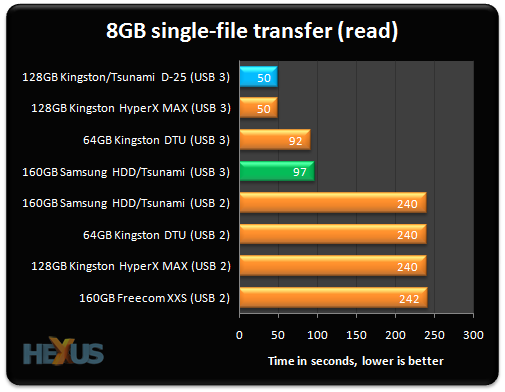
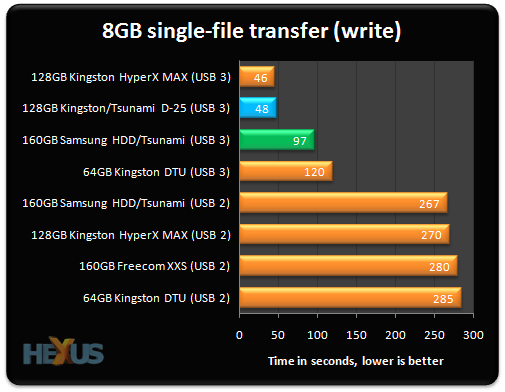
Copying a single large file ably demonstrates why USB 3.0 is desirable. Moving the data to-and-fro takes comfortably less than a minute on the SSD, translating into transfers exceeding 150MB/s. Strap in a fast spindle-based drive and the transfer averages over 80MB/s.
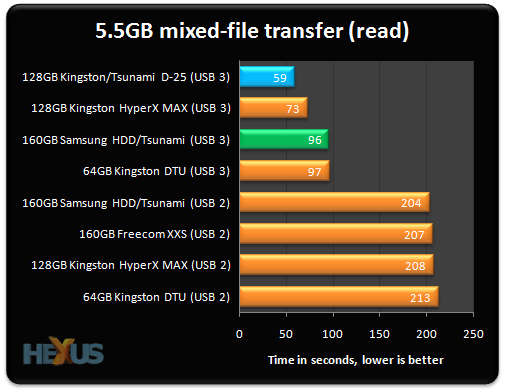
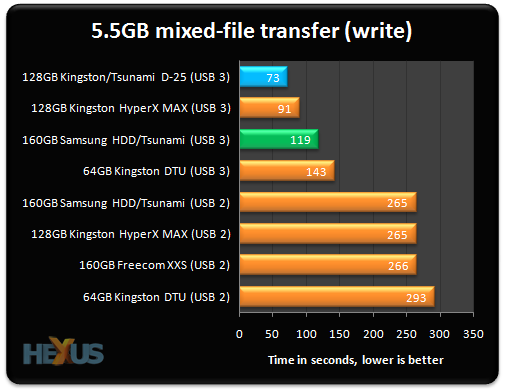
The Tsunami enclosure is good at facilitating transfers for folders filled with thousands of mixed-sized files. Indeed, it's appreciably quicker than the Kingston HyperX MAX.
Looking at mechanical storage, the transfer time is more than halved when changing interfaces.
Summary
There's little denying the intrinsic merit of USB 3.0 as a means of transferring large files between non-networked computers, assuming they're equipped with a SuperSpeed port. The single-cable connection is quick enough to put the onus on the speed of the attached storage.
Really coming to the fore when equipped with fast SSDs, Tsunami brings to market a USB 3.0 caddy with a mainstream price of just £16. Being drive-agnostic means you're not tied into any particular brand of storage, and we think something like a 60GB SandForce SSD or the 64GB Crucial RealSSD C300 would make an ideal partner for a combined outlay of just in excess of £100.
Heck, even if you can't stretch to an SSD, the speed benefits of putting a fast spindle-based drive are clear: imagine moving your 150GB music folder to-and-fro in comfortably less than half the time taken with USB 2.0.
Bottom line: recommended if you have the USB 3.0 infrastructure in place and are on the lookout for a cheap 2.5in enclosure for, ideally, an SSD.
The Good
Cheap-and-cheerful USB 3.0 enclosure
Slim and lightweight
The Bad
Could do with a longer USB 3.0 cable
HEXUS Rating

Tsunami D-25 USB 3.0 2.5in enclosure
HEXUS Awards

Tsunami D-25 USB 3.0 2.5in enclosure
HEXUS Where2Buy
The Tsunami D-25 USB 3.0 2.5in enclosure is available from SCAN.co.uk.
HEXUS Right2Reply
At HEXUS, we invite the companies whose products we test to comment on our articles. If any company representatives for the products reviewed choose to respond, we'll publish their commentary here verbatim.













